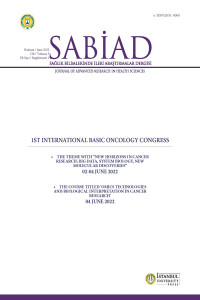NOVEL EPIGENETIC BIOMARKER DETERMINATION FOR OSCC BY ARRAY-BASED EPIGENOMIC AND TRANSCRIPTOMIC TECHNIQUES
Öz
Objectives: Oral squamous cell carcinoma (OSCC) has a high morbidity and mortality rates, but there are no reliable biomarkers to define patients in early
phases of disease. In our study (TUBITAK-SBAG-114S497), we aimed to investigate the potential epigenetic biomarker candidate genes observed
methylation-dependent expression loss via methylation and expression array methods in OSCC patients.
Material and Methods: Methylation and expression profiling in tumor and conjugate-normal tissue samples of 6 OSCC patients were analyzed by
“IlluminaHumanMethylation450 chips” and “Illumina iScan”, respectively. Methylation/expression array data were analyzed and interpreted by R(v3.5.1)
environment using ChAMP and limma/lumi packages, and then the significant decreased expression changes due to hypermethylation of the candidate
gene was detected. The selected candidate gene was validated in tumor and matched-normal tissues and body fluids (serum and saliva) of 20 OSCC
patients by QRT-PCR/QMSP methods.
Results: According to the array results, it was determined that the expression levels of the candidate gene were decreased due to methylation
(DiffScore:13.18826; FoldChange:-1.08345). This candidate gene (unpublished data), which plays an important role in ubiquitin-ligase activity, was found
to be methylated in 45% tumor, 40% matched-normal tissue, 10% serum and 30% saliva samples. 50% of the patients observed methylation in the tumor
tissue showed the differentially decreased expression levels.
Conclusion: It is thought that this candidate gene, whose expression level decreased due to methylation, will be a candidate epigenetic biomarker for the
early diagnosis of the subtypes of OSCC. Further validation of this candidate gene will be needed in the larger OSCC cohorts.
Anahtar Kelimeler
Oral Squamous Cell Carcinoma Methylation Expression Biomarker
Destekleyen Kurum
TUBITAK
Proje Numarası
TUBITAK-SBAG-114S497
Kaynakça
- Dela Cruz CS, Tanoue LT, Matthay RA. Lung cancer: epidemiology, etiology, and prevention. Clin Chest Med. 2011;32(4):605-44.
NOVEL EPIGENETIC BIOMARKER DETERMINATION FOR OSCC BY ARRAY-BASED EPIGENOMIC AND TRANSCRIPTOMIC TECHNIQUES
Öz
Objectives: Oral squamous cell carcinoma (OSCC) has a high morbidity and mortality rates, but there are no reliable biomarkers to define patients in early
phases of disease. In our study (TUBITAK-SBAG-114S497), we aimed to investigate the potential epigenetic biomarker candidate genes observed
methylation-dependent expression loss via methylation and expression array methods in OSCC patients.
Material and Methods: Methylation and expression profiling in tumor and conjugate-normal tissue samples of 6 OSCC patients were analyzed by
“IlluminaHumanMethylation450 chips” and “Illumina iScan”, respectively. Methylation/expression array data were analyzed and interpreted by R(v3.5.1)
environment using ChAMP and limma/lumi packages, and then the significant decreased expression changes due to hypermethylation of the candidate
gene was detected. The selected candidate gene was validated in tumor and matched-normal tissues and body fluids (serum and saliva) of 20 OSCC
patients by QRT-PCR/QMSP methods.
Results: According to the array results, it was determined that the expression levels of the candidate gene were decreased due to methylation
(DiffScore:13.18826; FoldChange:-1.08345). This candidate gene (unpublished data), which plays an important role in ubiquitin-ligase activity, was found
to be methylated in 45% tumor, 40% matched-normal tissue, 10% serum and 30% saliva samples. 50% of the patients observed methylation in the tumor
tissue showed the differentially decreased expression levels.
Conclusion: It is thought that this candidate gene, whose expression level decreased due to methylation, will be a candidate epigenetic biomarker for the
early diagnosis of the subtypes of OSCC. Further validation of this candidate gene will be needed in the larger OSCC cohorts.
Anahtar Kelimeler
Oral Squamous Cell Carcinoma Methylation Expression Biomarker
Proje Numarası
TUBITAK-SBAG-114S497
Kaynakça
- Dela Cruz CS, Tanoue LT, Matthay RA. Lung cancer: epidemiology, etiology, and prevention. Clin Chest Med. 2011;32(4):605-44.
Ayrıntılar
| Birincil Dil | İngilizce |
|---|---|
| Konular | Klinik Tıp Bilimleri |
| Bölüm | Toplantı Özeti |
| Yazarlar | |
| Proje Numarası | TUBITAK-SBAG-114S497 |
| Yayımlanma Tarihi | 9 Ağustos 2022 |
| Gönderilme Tarihi | 18 Temmuz 2022 |
| Yayımlandığı Sayı | Yıl 2022 Cilt: 5 Sayı: S-1 |


